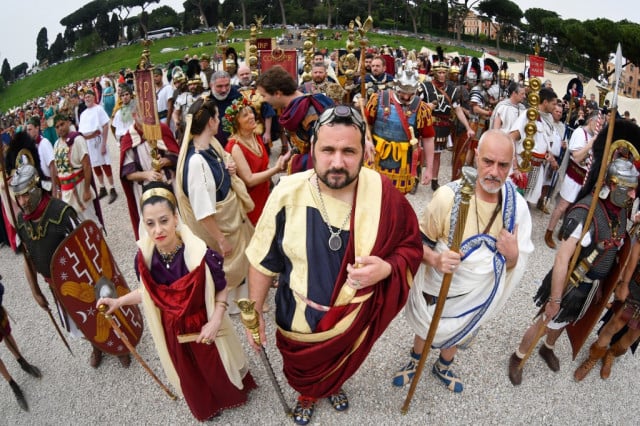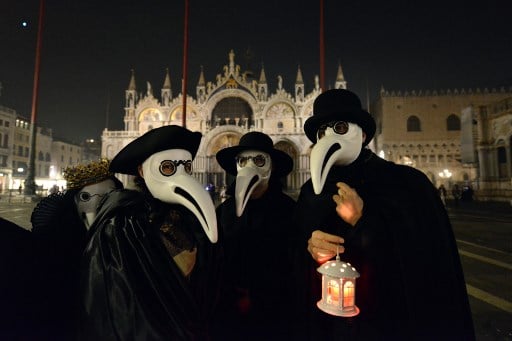Worried about coronavirus? Italy has a long history of fighting disease outbreaks

Italy has been struck hard by the coronavirus, with the number of cases rising at an exponential rate. Should we be so surprised, however? Some have suggested that the nation’s geography and history have had an important role to play in the number of epidemics that have struck it over the centuries.
Global hub, global problems
Italy’s role as the cradle and ‘home base’ for the Roman Empire made it uniquely suitable for the arrival of disease.
With a constant flow of people including troops, political figures, merchants and slaves moving in and out of central Italy, epidemics had little trouble spreading along main roads and trade routes. The cramped, tightly-packed streets of cities across the Italian Peninsula were also ideal breeding grounds.
Two major outbreaks of disease would ravage the Roman Empire over its existence. The first came in 165CE, when a plague, possibly a strain of smallpox, travelled with legions returning from wars against the Parthians. Those sick quickly passed the contagion on to others, and it soon spread from the east, right throughout the Mediterranean. Some suggest it killed up to 15% of the population of the Empire at its peak.

Photo: AFP
Indeed, the arrival of what has become known as the ‘Antonine Plague’ is considered to be a contributing factor in the halt of Roman expansion - there simply weren’t enough troops to press forwards.
A second outbreak of disease in 542CE effectively sounded the final death-knell for the Roman Empire. The ‘Justinian Plague’ - this time thought to be the Bubonic Plague - killed upwards of 30 million, again issuing from the east.
READ ALSO:
Such a virulent outbreak meant that the troops gamely attempting to defend the Western Roman Empire’s borders from Goths, Vandals and other tribal groups eventually buckled, and it was only a matter of time before the Empire crumbled as a political entity, as migrating groups swept through.
Tall Tales and Morbid Masks
Italy is far more well-known as a possible European ‘Ground Zero’ for the ‘Black Death’ of 1348. Many of us hear in history class of ships from the Black Sea port of Caffa, docking at Genoa and carrying the plague with them.
The Bubonic Plague, using infected fleas as a primary vector, would ravage Italy and the rest of Europe for the next three years. Estimates of the number of fatalities reach up to 475 million, across the planet - a significant percentage of the population.
Like nowhere else, the ‘Black Death’ left its mark on Italy.
Chroniclers, such as Angolo di Tura of Siena described the devastation: ‘Father abandoned child, wife husband, one brother another,' he wrote, 'for this plague seemed to strike through the breath and sight. And so they died. And no one could be found to bury the dead for money or friendship’. Indeed, the city’s cathedral remains functionally unfinished, the manpower lacking to complete the original design.
READ ALSO:
-
-
-
Perhaps the most famous legacy of the ‘Black Death’ in Italy is the ‘Decameron’ of Giovanni Boccacio.
Consisting of a number of amusing and instructive stories, the framing text of the piece concerns ten wealthy individuals who escape plague-struck Florence to wait things out at a villa. There, they take turns telling each other tales to pass the time. It is now one of the stalwarts of the Italian literary canon.
No less iconic were the 'plague doctor' masks that began to appear as part of the Venice carnival. These long-beaked, often full-face covering masks were identical to the masks worn by doctors who had treated the outbreaks of plague from the 14th to 17th centuries.
In these times, it was thought that 'miasma', or foul-smelling, poisonous vapours, were responsible for spreading disease, so garlands of aromatic plants were kept in the 'beak' to protect the wearer.
Venice was particularly susceptible to disease, being both a heavily-trafficked trading port and built atop a lagoon - indeed the city has had constant problems with outbreaks of disease for centuries. With Venice being particularly hard-hit by the coronavirus, the masks that one can find in almost every tourist shop have taken on a slightly more sinister tone.
Photo: AFP
Drain the Swamp
While outbreaks of the bubonic plague would ravage Italy until the invention of penicillin, by far the more devastating diseases faced by Italians were malaria and cholera.
Malaria found a natural home in many Italian cities built on or near swampy ground, such as Rome. Mosquitoes in stagnant swamps infected those they sucked blood from, with an estimated 15 - 20,000 succumbing each year, often children.
It wasn’t until the late 19th century that serious, large-scale draining of low-lying saturated ground was carried out, and the 20th century before government efforts to combat the disease led to a significant reduction in deaths.
READ ALSO:
Cholera was more of a problem. A water-borne contagion, it was transmitted through faecal matter, either in cesspits, water pumps, or through laundering clothes.
A series of outbreaks swept through during the course of the 19th century, hitting cities such as Naples very heavily. Despite the best efforts of public health officials, hundreds of thousands died over the course of these epidemics, and it wasn’t until 1973 that the Italian peninsula saw its final outbreak of the disease.
In flew Enza?
Italy was one of the nations impacted most heavily by the last great pandemic in human history - the ‘Spanish Flu’ of 1918.
This was probably due to a number of factors, chiefly Italy’s role in the war. Troops returning to and from the fronts in the north, down the length of the country, again was a natural vector for transmission.
The relatively slow pace of modernisation, particularly in more rural, impoverished communities, made it easier for the virus to spread. It’s estimated that around 390,000 Italians may have succumbed to the pandemic.
Time to worry?
Italy has been visited by both localised epidemics and global pandemics almost constantly over the last two millennia - there’s nothing to suggest that this won’t continue. However, this does not mean that we should necessarily be too worried about the coronavirus.
READ ALSO:
Improved medical science, rapid government interventions and advances in tracking movements mean that we may never again see anything on the scale of the Spanish Flu, let alone the Black Death. For now, practice basic hygiene, avoid travel to quarantined areas, and there is no need for concern.
Michael Stuchbery is a historian and author. Follow him on Twitter.
Comments
See Also
Global hub, global problems
Italy’s role as the cradle and ‘home base’ for the Roman Empire made it uniquely suitable for the arrival of disease.
With a constant flow of people including troops, political figures, merchants and slaves moving in and out of central Italy, epidemics had little trouble spreading along main roads and trade routes. The cramped, tightly-packed streets of cities across the Italian Peninsula were also ideal breeding grounds.
Two major outbreaks of disease would ravage the Roman Empire over its existence. The first came in 165CE, when a plague, possibly a strain of smallpox, travelled with legions returning from wars against the Parthians. Those sick quickly passed the contagion on to others, and it soon spread from the east, right throughout the Mediterranean. Some suggest it killed up to 15% of the population of the Empire at its peak.

Photo: AFP
Indeed, the arrival of what has become known as the ‘Antonine Plague’ is considered to be a contributing factor in the halt of Roman expansion - there simply weren’t enough troops to press forwards.
A second outbreak of disease in 542CE effectively sounded the final death-knell for the Roman Empire. The ‘Justinian Plague’ - this time thought to be the Bubonic Plague - killed upwards of 30 million, again issuing from the east.
READ ALSO:
Such a virulent outbreak meant that the troops gamely attempting to defend the Western Roman Empire’s borders from Goths, Vandals and other tribal groups eventually buckled, and it was only a matter of time before the Empire crumbled as a political entity, as migrating groups swept through.
Tall Tales and Morbid Masks
Italy is far more well-known as a possible European ‘Ground Zero’ for the ‘Black Death’ of 1348. Many of us hear in history class of ships from the Black Sea port of Caffa, docking at Genoa and carrying the plague with them.
The Bubonic Plague, using infected fleas as a primary vector, would ravage Italy and the rest of Europe for the next three years. Estimates of the number of fatalities reach up to 475 million, across the planet - a significant percentage of the population.
Like nowhere else, the ‘Black Death’ left its mark on Italy.
Chroniclers, such as Angolo di Tura of Siena described the devastation: ‘Father abandoned child, wife husband, one brother another,' he wrote, 'for this plague seemed to strike through the breath and sight. And so they died. And no one could be found to bury the dead for money or friendship’. Indeed, the city’s cathedral remains functionally unfinished, the manpower lacking to complete the original design.
READ ALSO:
Perhaps the most famous legacy of the ‘Black Death’ in Italy is the ‘Decameron’ of Giovanni Boccacio.
Consisting of a number of amusing and instructive stories, the framing text of the piece concerns ten wealthy individuals who escape plague-struck Florence to wait things out at a villa. There, they take turns telling each other tales to pass the time. It is now one of the stalwarts of the Italian literary canon.
No less iconic were the 'plague doctor' masks that began to appear as part of the Venice carnival. These long-beaked, often full-face covering masks were identical to the masks worn by doctors who had treated the outbreaks of plague from the 14th to 17th centuries.
In these times, it was thought that 'miasma', or foul-smelling, poisonous vapours, were responsible for spreading disease, so garlands of aromatic plants were kept in the 'beak' to protect the wearer.
Venice was particularly susceptible to disease, being both a heavily-trafficked trading port and built atop a lagoon - indeed the city has had constant problems with outbreaks of disease for centuries. With Venice being particularly hard-hit by the coronavirus, the masks that one can find in almost every tourist shop have taken on a slightly more sinister tone.
Photo: AFP
Drain the Swamp
While outbreaks of the bubonic plague would ravage Italy until the invention of penicillin, by far the more devastating diseases faced by Italians were malaria and cholera.
Malaria found a natural home in many Italian cities built on or near swampy ground, such as Rome. Mosquitoes in stagnant swamps infected those they sucked blood from, with an estimated 15 - 20,000 succumbing each year, often children.
It wasn’t until the late 19th century that serious, large-scale draining of low-lying saturated ground was carried out, and the 20th century before government efforts to combat the disease led to a significant reduction in deaths.
READ ALSO:
Cholera was more of a problem. A water-borne contagion, it was transmitted through faecal matter, either in cesspits, water pumps, or through laundering clothes.
A series of outbreaks swept through during the course of the 19th century, hitting cities such as Naples very heavily. Despite the best efforts of public health officials, hundreds of thousands died over the course of these epidemics, and it wasn’t until 1973 that the Italian peninsula saw its final outbreak of the disease.
In flew Enza?
Italy was one of the nations impacted most heavily by the last great pandemic in human history - the ‘Spanish Flu’ of 1918.
This was probably due to a number of factors, chiefly Italy’s role in the war. Troops returning to and from the fronts in the north, down the length of the country, again was a natural vector for transmission.
The relatively slow pace of modernisation, particularly in more rural, impoverished communities, made it easier for the virus to spread. It’s estimated that around 390,000 Italians may have succumbed to the pandemic.
Time to worry?
Italy has been visited by both localised epidemics and global pandemics almost constantly over the last two millennia - there’s nothing to suggest that this won’t continue. However, this does not mean that we should necessarily be too worried about the coronavirus.
READ ALSO:
Improved medical science, rapid government interventions and advances in tracking movements mean that we may never again see anything on the scale of the Spanish Flu, let alone the Black Death. For now, practice basic hygiene, avoid travel to quarantined areas, and there is no need for concern.
Michael Stuchbery is a historian and author. Follow him on Twitter.
Join the conversation in our comments section below. Share your own views and experience and if you have a question or suggestion for our journalists then email us at [email protected].
Please keep comments civil, constructive and on topic – and make sure to read our terms of use before getting involved.
Please log in here to leave a comment.